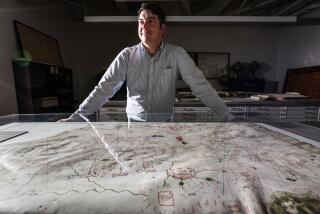And on Your Left, You Can Just Make Out the Insightful Columnist Gene
- Share via
The most important cartographers in the world these days don’t work at Rand McNally or the CIA. They’re not much interested in mountains and rivers and shifting national boundaries. In fact, they don’t necessarily know much about traditional geography at all.
No, the influential map makers of the 1990s ply their trade in molecular biology labs, charting the geography of genes. They’re rapidly creating a veritable atlas of human, plant and animal genes, figuring out where individual genes are located and what they do.
This is proving to be one of the most productive ventures in the history of cartography: gene mapping is transforming biology, agriculture and medicine as surely as mapping the New World transformed Europe. This year alone, researchers have located more than 45 new disease-causing genes in humans--just yesterday, scientists announced the discovery of the gene that is believed to cause half of all inherited cases of breast cancer. The better-than-gene-a-week pace has helped spawn the biotech business boom.
But what good is an atlas without a guidebook? Alas, there are no Zagats or Guide Michelins for the genome just yet, no formal tours of the hot spots on uncharted chromosomes. To help rectify this problem, a few experts below point out their favorite sites on the gene map and explain where are the most interesting places to visit:
* “The HOX genes,” offers Edward P. Lewis, the Thomas Hunt Morgan Professor of Molecular Biology at CalTech. “They are the only way an organism can make a head, thorax and abdomen. They do it by telling the other genes what to do. That part of the gene has not changed for over 500 million years.”
* “LINE 1 and LRE1, LRE2 and LRE3,” says Maxine Singer, a molecular biologist who is president of the Carnegie Institution of Washington and who has a lab at the National Cancer Institute. “They are places where active copies of the only known copies of human transposable--so-called jumping genes--are found. They’re mutagenic when they jump: that is, they cause mutations and disease, like muscular dystrophy, when they move. They appear to be active in early embryonic cells. They’re troublemakers, and I’m particularly interested in why these troublemakers have persisted for so long in the genome because of all the trouble they cause.”
* “ Rin ,” says William R. Hyatt, the vice president of research and development for Calgene, the company that developed the genetically engineered FlavrSavr tomato. “It’s a spot on the tomato locus and mutations map onto there. It’s a natural mutant and it inhibits ripening. It’s not so much a gene as it is a site. The point is, nobody knows exactly what this gene or locus is--how it exerts this multitude of effects on the tomato and through what mechanism. We’ve only recently begun to clone it.”
* “The sry gene of the Y chromosome,” offers Robert L. Sinsheimer, an emeritus professor at UC Santa Barbara and a pioneer in the early days of bacterial virus research. “This was thought to be the central gene for determining maleness and femaleness. . . . There are also corresponding genes on the X (female) chromosome. We thought we understood which genes made you a boy or a girl. It seemed pretty clear and now it’s confused.”
* “The genes responsible for Type 1 diabetes,” says venture capitalist Kevin Kinsella, who is also chief executive of La Jolla-based Sequana Therapeutics. “The sites are chromosomes 6, 11 and 18 and near HLA. There may be as many as five other genes implicated. I’m much more interested now in how gene complexes interact to produce a disease rather than just looking for single genes. The problem is finding all those multiple locations. So I think we’re moving into a new era of gene discovery.”
* “The ACC Synthase genes,” suggests David Evans, business development vice president for DNA Plant Technology, which was involved in creating Brown & Williamson’s Y-1 high nicotine tobacco. “They oversee the biosynthesis of ethylene. They control ripening and rotting. It’s a gene family involved in part of the plant’s defense mechanisms against disease. In some fruits, like bananas and tomatoes, there is a direct association between ethylene and fruit rotting. We’re looking to suspend that.”
* “The genes for the NMDA receptor,” offers Daniel Koshland, a molecular biologist at UC Berkeley and the editor of Science magazine. “It’s the receptor in the brain involved in how we record memory. I’m trying to understand the biochemical shift between short-term memory and long-term memory. We’re looking for the gene for it. Where it is on the chromosome is not that important at the moment--but it may be. I don’t have any guarantees that its location is important but that may turn out to give us important insights. Sometimes gene geography can be very important.”
* “The histone gene clusters,” says Laurence Kedes, director of the Institute for Genetic Medicine at USC. “These are the genes that make the proteins that coat the chromosomes. They’re the ones responsible for taking the threads of DNA and compacting them into cells. Otherwise, they would be yards long.”
* MEDICAL BREAKTHROUGH
Researchers identify gene responsible for some breast cancers. A1





